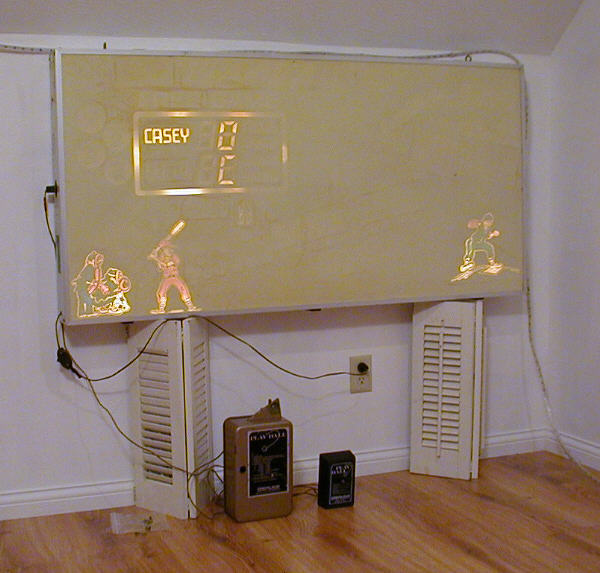
Gremlin White and Black Games
The early Gremlin wall games, Play Ball and Trapshoot, are known as "White Games". The term "White Game" refers to the color of the game panel.

Gremlin Industries Play Ball, a "White Game", power on.
There is no silk-screening on the external surface of a white game panel, only on the underside. Therefore, when a white game is turned off, it appears to be a plain white panel hanging on the wall.
The white game panel is extremely thin. It is difficult to find one of the White Games today in which the panel has not oxidized, making it brittle and easily punctured, torn or cracked. In addition, the heat from the lamps beneath the panel (which undoubtedly encouraged the oxidation problem) causes many panels to warp, form scorch marks, and/or to yellow.
Later Gremlin games, including Fooswall, All Star, Tenpin, Grand Slam, and Skeet Shoot, are known as "Black Games", again referring to the color of the game panel.
Gremlin Industries Skeet Shoot, a "Black Game", power off.
The Black Game panel was substantially thicker than that of the White Games, and made of a polycarbonate plastic material that was more resistant to oxidation. The thickness of the panel offered more resistance to heat damage, although the black color would absorb heat more readily than the White Panel games. A cooling fan was also added to the Black Games to combat the heat buildup.
Another major change was that, whereas the White Games were completely blank when the power was turned off, later Black Games were silk-screened on the outer surface as well as the underside. Since these games were often turned off during meal times in bars, bartenders would sometimes fail to turn them back on. The White Games were completely blank white panels when the power was off.
Although this was thought to be advantageous to the bar owner, since it was not distracting in this state, it was a disadvantage to the operator since potential players might have no idea that it was a game waiting to be played. The Black Games, with the external silk-screening, made it clear that this was a game available to be played. Bartenders were therefore often reminded to turn the games on, so it could be played.
One black game which was not silk-screened on the exterior panel was the later version of Trapshoot. This game, like the earlier white games, was completely blank when powered off. To my knowledge, Trapshoot is the only game which was produced in both white and black versions.
Because of the durability of the Black Game panels, it is more likely to locate surviving Black Games in good condition than White Games.